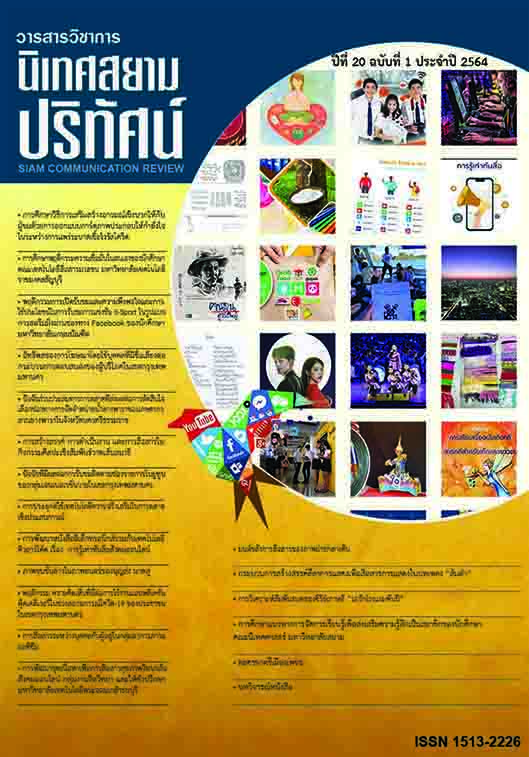The Development of Electronics Book Combined with the QR Code Technology Titled in “Social Media Literacy”
Main Article Content
Abstract
This research aimed to develop and find quality, assessment of perception and satisfaction of the sample group toward Electronics book combined with the QR code technology titled in “Social Media literacy ”, the research tools were as follows: 1) content evaluation form 2) media evaluation form for electronics book combined with the QR code technology 3) evaluation form of the sample's perception on electronics book combined with the QR code technology 4) evaluation form measuring subject group satisfaction to electronics book combined with the QR code technology. The sample group used for this evaluation consists of 30 people from 2nd year of undergraduate level from the department of Educational Communications and Technology who registered for the course of ETM 202 Advertising and Public Relations during the first semester of the academic year 2020 selected by purposive sampling method from the students who learned by the developed electronics book and pleased to response the questionnaires. The expert evaluation results showed that the content quality assessment was at a very good level. (=4.70, S.D. = 0.40). The media quality evaluation result was at a very good level. (
=4.64, S.D. = 0.46) The evaluation of the perception of the sample was in at the highest level (
=4.54, S.D. = 0.59). And the satisfaction evaluation result of the sample group was at the highest level (
=4.57, S.D. = 0.56). Therefore, the developed electronics book were in a high quality and could be used practically
Article Details
References
คณาวุฒิ ไตรพิพัฒนพงษ์ และคณะ. (2562). การพัฒนาหนังสืออิเล็กทรอนิกส์ร่วมกับเทคโนโลยีคิวอาร์โค้ด เรื่อง ศิษย์ดีที่ครูภูมิใจ คณะครุศาสตร์อุตสาหกรรมและเทคโนโลยี. โครงงานปริญญาบัณฑิต สาขาวิชาเทคโนโลยีการศึกษาและสื่อสารมวลชน คณะครุศาสตร์อุตสาหกรรมและเทคโนโลยี, มหาวิทยาลัยเทคโนโลยีพระจอมเกล้าธนบุรี.
จันทร์เพ็ญ รักษ์ธรรม. (2543). การเปรียบเทียบค่าความเชื่อมั่นของมาตรวัดเจตคติต่อครูแบบลิเคอร์ทที่มีรูปแบบการตอบต่างกัน. วิทยานิพนธ์ปริญญามหาบัณฑิต สาขาการวัดผลและวิจัยการศึกษา คณะศึกษาศาสตร์, มหาวิทยาลัยสงขลานครินทร์.
ณีรนุช ปี่แก้ว. (2561). การพัฒนาหนังสืออิเล็กทรอนิกส์โดยใช้เทคโนโลยีคิวอาร์โค้ดร่วมกับนิทรรศการแบบมีส่วนร่วม เรื่อง การรู้เท่าทันสื่อ สำหรับนักศึกษาระดับปริญญาตรี. วิทยานิพนธ์ปริญญามหาบัณฑิต สาขาวิชาเทคโนโลยีการเรียนรู้และสื่อสารมวลชน คณะครุศาสตร์อุตสาหกรรมและเทคโนโลยี, มหาวิทยาลัยเทคโนโลยีพระจอมเกล้าธนบุรี.
ดิศวิตา ทองสง. (2555). ทฤษฏี ADDIE MODEL. เข้าถึงได้จาก https://sites.google.com/site/prae8311/hlak-kar-xxkbaeb-khxng-addie-model.
ธนากร แสนผูก. (2557). หนังสืออิเล็กทรอนิกส์แบบมีปฏิสัมพันธ์ เรื่อง ว่าวไทย. วิทยานิพนธ์ปริญญามหาบัณฑิต สาขาวิชาคอมพิวเตอร์และเทคโนโลยีสารสนเทศ คณะครุศาสตร์อุตสาหกรรมและเทคโนโลยี, มหาวิทยาลัยเทคโนโลยีพระจอมเกล้าธนบุรี.
ชนัญชิดา คามินเศก. (2553). การรับรู้รณรงค์สื่อ Quit Line 1600. วิทยานิพนธ์ปริญญามหาบัณฑิต สาขาวิชานิเทศศาสตร์สื่อสารการตลาด คณะนิเทศศาสตร์, มหาวิทยาลัยธุรกิจบัณฑิต.
ศิรินันท์ สนโศรก. (2557). ความหมายและประเภทของสื่อสังคมออนไลน์. เข้าถึงได้จาก https://sites.google.com/site/sirinunsonsok/e-book/khwam-ru-keiyw-kab-hnangsux-xilekthrxniks-e-book.
สำนักงานปลัดกระทรวงศึกษา. (2561). qr-code-คืออะไร. เข้าถึงได้จาก http://www.ops.moe.go.th/ops2017/สาระน่ารู้/1877-qr-code-คืออะไร.
SMFOREDU. (2557). ความหมายและประเภทของสื่อสังคมออนไลน์. เข้าถึงได้จาก http://smforedu.blogspot.com/2014/02/blog-post.html.


